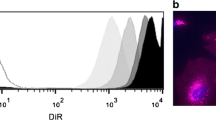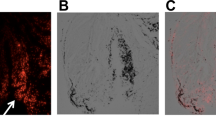Abstract
Purpose
The purpose of this study was to investigate the feasibility of dual magnetic resonance imaging (MRI) reporter genes, including ferritin heavy subunit (Fth) and transferrin receptor (TfR), which provide sufficient MRI contrast for in vivo MRI tracking, and the Deltex-1 (DTX1) gene, which promotes human mesenchymal stem cell (hMSC) differentiation to smooth muscle cells (SMCs), to treat closed penile fracture (CPF).
Methods
Multi-gene co-expressing hMSCs were generated. The expression of mRNA and proteins was assessed, and the original biological properties of hMSCs were determined and compared. The intracellular uptake of iron was evaluated, and the ability to differentiate into SMCs was detected. Fifty rabbits with CPF were randomly transplanted with PBS, hMSCs, Fth-TfR-hMSCs, DTX1-hMSCs, and Fth-TfR-DTX1-hMSCs. In vivo MRI was performed to detect the distribution and migration of the grafted cells and healing progress of CPF, and the results were correlated with histology.
Results
The mRNA and proteins of the multi-gene were highly expressed. The transgenes could not influence the original biological properties of hMSCs. The dual MRI reporter genes increased the iron accumulation capacity, and the DTX1 gene promoted hMSC differentiation into SMCs. The distribution and migration of the dual MRI reporter gene-modified hMSCs, and the healing state of CPF could be obviously detected by MRI and confirmed by histology.
Conclusion
The dual MRI reporter genes could provide sufficient MRI contrast, and the distribution and migration of MSCs could be detected in vivo. The DTX1 gene can promote MSC differentiation into SMCs for the treatment of CPF and effectively inhibit granulation tissue formation.






Similar content being viewed by others
References
Kendirci M, Trost L, Bakondi B et al (2010) Transplantation of nonhematopoietic adult bone marrow stem/progenitor cells isolated by p75 nerve growth factor receptor into the penis rescues erectile function in a rat model of cavernous nerve injury. J Urol 184:1560–1566
Song YS, Lee HJ, Park IH et al (2007) Potential differentiation of human mesenchymal stem cell transplanted in rat corpus cavernosum toward endothelial or smooth muscle cells. Int J Impot Res 19:378–385
Verfailie CM (2002) Adult stem cells: assessing the case for pluripotency. Trends Cell Biol 12:502–508
Floren M, Bonani W, Dharmarajan A et al (2016) Human mesenchymal stem cells cultured on silk hydrogels with variable stiffness and growth factor differentiate into mature smooth muscle cell phenotype. Acta Biomater 31:156–166
Guo RM, Cao N, Zhang F et al (2012) Controllable labelling of stem cells with a novel superparamagnetic iron oxide-loaded cationic nanovesicle for MR imaging. Eur Radiol 22:2328–2337
Neri M, Maderna C, Cavazzin C et al (2008) Efficient in vitro labeling of human neural precursor cells with superparamagnetic iron oxide particles: relevance for in vivo cell tracking. Stem Cells 26:505–516
Srivastava AK, Bulte JW (2014) Seeing stem cells at work in vivo. Stem Cell Rev 10:127–144
Jung J, Moon N, Ahn JY et al (2009) Mesenchymal stromal cells expanded in human allogenic cord blood serum display higher self-renewal and enhanced osteogenic potential. Stem Cells Dev 18:559–571
Cromer Berman SM, Kshitiz WCJ, Orukari I et al (2013) Cell motility of neural stem cells is reduced after SPIO-labeling, which is mitigated after exocytosis. Magn Reson Med 69:255–262
Muja N, Cohen ME, Zhang J et al (2011) Neural precursors exhibit distinctly different patterns of cell migration upon transplantation during either the acute or chronic phase of EAE: a serial MR imaging study. Magn Reson Med 65:1738–1749
Pereira SM, Moss D, Williams SR et al (2015) Overexpression of the MRI reporter genes ferritin and transferrin receptor affect iron homeostasis and produce limited contrast in mesenchymal stem cells. Int J Mol Sci 16:15481–15496
Deans AE, Wadghiri YZ, Bernas LM et al (2006) Cellular MRI contrast via coexpression of transferrin receptor and ferritin. Magn Reson Med 56:51–59
Kim HS, Woo J, Choi Y et al (2015) Noninvasive MRI and multilineage differentiation capability of ferritin-transduced human mesenchymal stem cells. NMR Biomed 28:168–179
Muckenthaler MU, Galy B, Hentze MW (2008) Systemic iron homeostasis and the iron-responsive element/iron-regulatory protein (IRE/IRP) regulatory network. Ann Rev Nutr 28:197–213
Kurpinski K, Lam H, Chu J et al (2010) Transforming growth factor-beta and Notch signaling mediate stem cell differentiation into smooth muscle cells. Stem Cells 28:734–742
Tang Y, Urs S, Boucher J et al (2010) Notch and transforming growth factor-beta (TGFbeta) signaling pathways cooperatively regulate vascular smooth muscle cell differentiation. J Biol Chem 285:17556–17563
Hsiao HW, Liu WH, Wang CJ et al (2009) Deltex1 is a target of the transcription factor NFAT that promotes T cell anergy. Immunity 31:72–83
Dezawa M, Ishikawa H, Itokazu Y et al (2005) Bone marrow stromal cells generate muscle cells and repair muscle degeneration. Science 309:314–317
Li Z, Hu X, Mao J et al (2015) Optimization of mesenchymal stem cells (MSCs) delivery dose and route in mice with acute liver injury by bioluminescence imaging. Mol Imaging Biol 17:185–194
Kim HS, Cho HR, Choi SH et al (2010) In vivo imaging of tumor transduced with bimodal lentiviral vector encoding human ferritin and green fluorescent protein on a 1.5T clinical magnetic resonance scanner. Cancer Res 70:7315–7324
Huber RM, Rajski M, Sivasankaran B et al (2013) Deltex-1 activates mitotic signaling and proliferation and increases the clonogenic and invasive potential of U373 and LN18 glioblastoma cells and correlates with patient survival. PLoS One 8:e57793
Li X, Yang Q, Bai J et al (2015) Identification of appropriate reference genes for human mesenchymal stem cell analysis by quantitative real-time PCR. Biotechnol Lett 37:67–73
Arbab AS, Bashaw LA, Miller BR et al (2003) Characterization of biophysical and metabolic properties of cells labeled with superparamagnetic iron oxide nanoparticles and transfection agent for cellular MR imaging. Radiology 229:838–846
Kostura L, Kraitchman DL, Mackay AM et al (2004) Feridex labeling of mesenchymal stem cells inhibits chondrogenesis but not adipogenesis or osteogenesis. NMR Biomed 17:513–517
Delcroix GJ, Jacquart M, Lemaire L et al (2009) Mesenchymal and neural stem cells labeled with HEDP-coated SPIO nanoparticles: in vitro characterization and migration potential in rat brain. Brain Res 1255:18–31
Cohen B, Ziv K, Plaks V et al (2009) Ferritin nanoparticles as magnetic resonance reporter gene. Wiley interdiscip Rev Nanomed Nanobiotechnol 1:181–188
Vande Velde G, Rangarajan JR, Toelen J et al (2011) Evaluation of the specificity and sensitivity of ferritin as an MRI reporter gene in the mouse brain using lentiviral and adeno-associated viral vectors. Gene Ther 18:594–605
Berman SC, Galpoththawela C, Gilad AA et al (2011) Long-term MR cell tracking of neural stem cells grafted in immunocompetent versus immunodeficient mice reveals distinct differences in contrast between live and dead cells. Magn Reson Med 65:564–574
Kedziorek DA, Muja N, Walczak P et al (2010) Gene expression profiling reveals early cellular responses to intracellular magnetic labeling with superparamagnetic iron oxide nanoparticles. Magn Reson Med 63:1031–1043
Hsiao JK, Chu HH, Wang YH et al (2008) Macrophage physiological function after superparamagnetic iron oxide labeling. NMR Biomed 21:820–829
Author information
Authors and Affiliations
Corresponding author
Ethics declarations
Conflict of Interest
The authors have declared that they have no conflict of interest.
Rights and permissions
About this article
Cite this article
Guo, R., Li, Q., Yang, F. et al. In Vivo MR Imaging of Dual MRI Reporter Genes and Deltex-1 Gene-modified Human Mesenchymal Stem Cells in the Treatment of Closed Penile Fracture. Mol Imaging Biol 20, 417–427 (2018). https://doi.org/10.1007/s11307-017-1128-0
Published:
Issue Date:
DOI: https://doi.org/10.1007/s11307-017-1128-0




